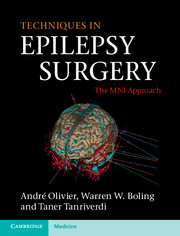Book contents
- Frontmatter
- Contents
- Acknowledgment
- Preface
- 1 History of epilepsy surgery
- 2 The search for the epileptic focus: investigation of the surgical candidate
- 3 Surgical anatomy
- 4 Neuronavigation and preoperative brain mapping
- 5 Stereoelectroencephalography (stereotactic intracranial recording)
- 6 Anesthesia and awake procedure
- 7 Peroperative brain mapping
- 8 Endopial resection (intervascular endopial gyral emptying)
- 9 Surgery of temporal lobe epilepsy: cortico-amygdalohippocampectomy
- 10 Surgery of temporal lobe epilepsy: transcortical selective amygdalohippocampectomy
- 11 Surgery of central area epilepsy
- 12 Surgery of frontal lobe epilepsy
- 13 Surgery of parietal lobe epilepsy
- 14 Surgery of insular lobe epilepsy
- 15 Surgery of occipital lobe epilepsy
- 16 Hemispherectomy
- 17 Callosotomy
- 18 Epilepsy and brain tumors
- 19 Surgical treatment of cortical dysplasias
- 20 Reoperations in failed epilepsy surgery
- 21 Alternative procedures in surgery for epilepsy
- 22 Complications of epilepsy surgery
- 23 Quality of life after epilepsy surgery
- Index
- References
14 - Surgery of insular lobe epilepsy
Published online by Cambridge University Press: 05 October 2012
- Frontmatter
- Contents
- Acknowledgment
- Preface
- 1 History of epilepsy surgery
- 2 The search for the epileptic focus: investigation of the surgical candidate
- 3 Surgical anatomy
- 4 Neuronavigation and preoperative brain mapping
- 5 Stereoelectroencephalography (stereotactic intracranial recording)
- 6 Anesthesia and awake procedure
- 7 Peroperative brain mapping
- 8 Endopial resection (intervascular endopial gyral emptying)
- 9 Surgery of temporal lobe epilepsy: cortico-amygdalohippocampectomy
- 10 Surgery of temporal lobe epilepsy: transcortical selective amygdalohippocampectomy
- 11 Surgery of central area epilepsy
- 12 Surgery of frontal lobe epilepsy
- 13 Surgery of parietal lobe epilepsy
- 14 Surgery of insular lobe epilepsy
- 15 Surgery of occipital lobe epilepsy
- 16 Hemispherectomy
- 17 Callosotomy
- 18 Epilepsy and brain tumors
- 19 Surgical treatment of cortical dysplasias
- 20 Reoperations in failed epilepsy surgery
- 21 Alternative procedures in surgery for epilepsy
- 22 Complications of epilepsy surgery
- 23 Quality of life after epilepsy surgery
- Index
- References
Summary
Introduction
The German anatomist Reil named the insula the island, insula in Latin, because it is surrounded and completely hidden from view by the opercula of the frontal, parietal, and temporal lobes. The insula represents a large cortical area that the nineteenth century French anatomists identified as the fifth lobe of the brain. However, it has remained a somewhat obscure cortical structure mostly because it is covered from view by the opercula making it difficult to access and study. Perhaps due to the challenges inherent in studying the insula, it has generated considerable interest by anatomists and physiologists over the years. From an epilepsy perspective, the role of the insula in the epileptic network is poorly understood, and the decision to include the insula in a resection for epilepsy continues to be controversial.
Guillaume and Mazars reported their approach to insula resection when the electrocorticography revealed epileptic activity arising from or spreading to the insula as early as 1949. The technique described an opercular resection to expose the insula fully. At the Montreal Neurological Institute (MNI), Penfield and Jasper recognized epileptic activity arising from the insula and postulated its being an epileptic focus, as well as the possibility that an insula seizure focus may be a reason for failure in surgery for temporal lobe epilepsy. This notion led to an enthusiasm to investigate the insula with ECOG during temporal lobe surgery and many insular lobe resections were performed up to the 1960s. The experience of insula resection at the MNI was reported by Silfvenius et al. in 1964, which was the most comprehensive review of surgery in the insula for a presumed seizure focus. The analysis revealed no improvement in seizure freedom in those individuals with either a resection of the EEG abnormal region in the insula or complete resection of the insula itself. In addition, significantly more neurological morbidity was associated with surgery in the insula.
- Type
- Chapter
- Information
- Techniques in Epilepsy SurgeryThe MNI Approach, pp. 178 - 185Publisher: Cambridge University PressPrint publication year: 2012



